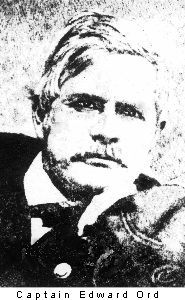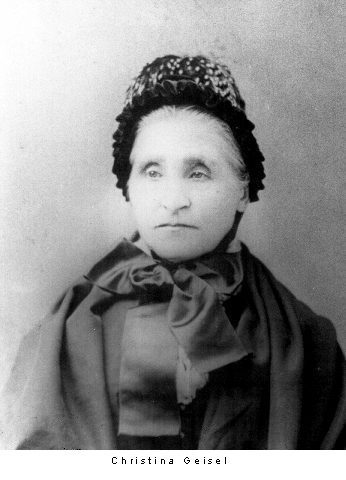History of the Geisel Monument and the Last Hanging in Curry County
 John and Christina Geisel were married in May 6, 1842 in Butler County, Ohio. Before making there way west the lived in Kentucky and Indiana, and finally Oregon. In 1854 they settled about 6 miles north of the mouth of the Rogue River on a bluff of the ocean bench. On February 22, 1856 the family consisted of John, Christina and 5 children, three boys and two girls. The oldest child was a girl of 13 years and the youngest was a baby girl about two weeks old.
John and Christina Geisel were married in May 6, 1842 in Butler County, Ohio. Before making there way west the lived in Kentucky and Indiana, and finally Oregon. In 1854 they settled about 6 miles north of the mouth of the Rogue River on a bluff of the ocean bench. On February 22, 1856 the family consisted of John, Christina and 5 children, three boys and two girls. The oldest child was a girl of 13 years and the youngest was a baby girl about two weeks old.
They lived in a house that also served as a hotel and store. The house was about 30 x 35 feet and was two stories high, with three outside doors. The house had 12 rooms and 12 windows, and was a framed house built out of whipsawed lumber. The house was nearly new. They valued the house at $1,100.00. In addition to the house they had three 14 x 20 one room mining cabins with stone chimneys. These had also been built out of whipsawed lumber and were nearly new. They valued the cabins at $150.00 each. A large house near their dwelling was being used as a store. This building was 20 x 30 and one story high and built of lumber. They valued this at $800.00.
THE MASSACRE
On February 21, 1856, Ben Wright, the Indian Agent for the area paid a visit to the Geisels. He told them that the Indians were well and peaceably disposed towards the white people and that there was no danger of an attack from them. On the following night a “tame” Indian who had been working for them and who had been out hunting their hogs that day, returned to their house around midnight and knocked on the door asking to be let in. They knew his voice and since they were not suspecting any danger, John Geisel got out of bed and opened the door. As soon as the door was opened the Indians that had been working for them and three or four others rushed in immediately and began a murderous assault on John.
Although Christina had given birth to Annie on January 28, 1856, and had not yet fully recovered her strength, she rushed to John’s side to assist him and received a painful cut that nearly severed her finger. Christina was soon over powered and John was killed. The oldest daughter, Mary, born February 14, 1843, was dragged out of her bed and her and Christina were securely bound. Her little boys, Andrew 5, Henry 7 and John 9, were then brought out one by one killed in her presence while the Indians made her watch. The Indians then removed Christina and her daughters from the house in their night clothes and more Indians showed up. They ransacked and burned the houses without removing the bodies of John or the boys.
The Indians stayed at the Geisel residence for about an hour and a half and then started on the return trip up river. Christina and Mary were not permitted to take any clothing or shoes. About a mile from the Geisel residence the Indians stopped at a cabin lived in by a settler named McPherson. He was immediately killed in their presence and after the cabin was ransacked it was burned. Not far from there the Indians came upon another man in a cabin and killed him. By this time it was daylight and Christina could see several dead people near the trail to the river. Their houses were burning and their fences were destroyed.
Read more



 John and Christina Geisel were married in May 6, 1842 in Butler County, Ohio. Before making there way west the lived in Kentucky and Indiana, and finally Oregon. In 1854 they settled about 6 miles north of the mouth of the Rogue River on a bluff of the ocean bench. On February 22, 1856 the family consisted of John, Christina and 5 children, three boys and two girls. The oldest child was a girl of 13 years and the youngest was a baby girl about two weeks old.
John and Christina Geisel were married in May 6, 1842 in Butler County, Ohio. Before making there way west the lived in Kentucky and Indiana, and finally Oregon. In 1854 they settled about 6 miles north of the mouth of the Rogue River on a bluff of the ocean bench. On February 22, 1856 the family consisted of John, Christina and 5 children, three boys and two girls. The oldest child was a girl of 13 years and the youngest was a baby girl about two weeks old.